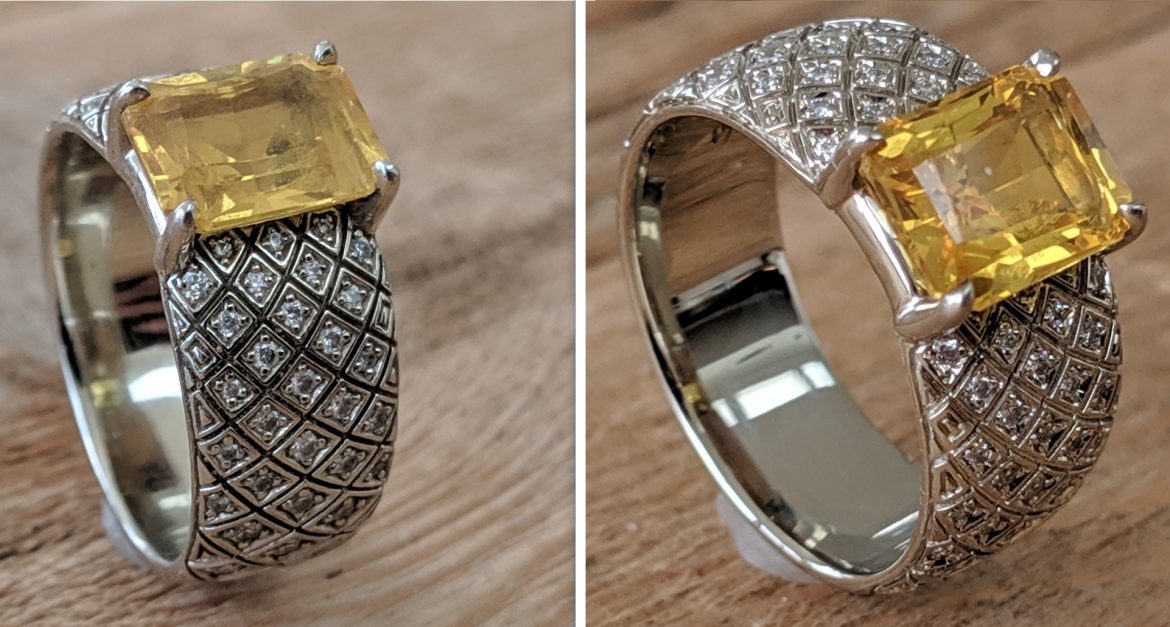
Cleaning your fine jewelry at home might seem a little daunting at first, but it’s not as difficult an undertaking as you might think. In fact, most people already have the cleaning items that they will need in their household. And since everyone wants their jewelry to look its best, we’ve provided some pro tips to keep your fine jewelry looking shiny and bright like it should.
Cleaning and polishing the metals
Some of the most popular precious metals used for jewelry are gold, silver, platinum and titanium. The proper method for cleaning fine jewelry made from these metals is described below:
Gold – Mix a little bit of dish soap and a little warm water and then soak your gold jewelry for 4-5 minutes. Gently go over the crevices with a soft toothbrush to remove the dirt and grime that sometimes collects in these areas. When you’re finished, take a dry, soft, and lint-free cloth and carefully buff the jewelry piece dry. Note: If your gold jewelry has begun to tarnish, you can make a mixture of lukewarm water, dish soap and just a few drops of ammonia and carefully use it to clean your jewelry. However, use this mixture sparingly, as overusing on jewelry pieces with gemstones that are embedded in the gold, can cause their settings to loosen.
Silver – Like gold, silver can be cleaned by soaking it for a few minutes with a little dish soap and water. After you’ve soaked it, rinse with cool water. For jewelry pieces with heavier tarnishing, use a soft cloth dipped in a mixture of 3 parts baking soda and one part water to gently clean the jewelry. When you’re finished, take a dry, soft, lint-free cloth to buff and dry the jewelry.
Platinum – Again, a little dish soap and a little warm water can be used for cleaning jewelry made from platinum too. When the jewelry is finished soaking, rinse with warm water. You can remove more stubborn dirt by gently scrubbing the metal with a soft toothbrush. Dry and buff with a lint-free, soft cloth.
Titanium – The same mixture can also be used for titanium jewelry. Rinse with warm water and be sure to buff dry with a soft, lint-free cloth as well. If you don’t do this step, you’ll get unsightly water spots on your jewelry. If need be, you can also use amononia (or even Windex, which contains ammonia) to remove more stubborn dirt.
Cleaning and polishing the gemstones
Diamonds – While diamonds are stronger and harder than other gemstones, they can still be damaged if not properly cared for as well as lose some of their gorgeous luster.To clean diamond jewelry, soak it in a mixture of warm almost hot water and mild dishwashing soap. The diamond itself can soak for 20-30 minutes. Once it’s finished soaking, remove the jewelry piece from the soap-water solution and gently brush it with a soft toothbrush, making sure to use the bristles of the toothbrush to work loose all the dirt and grime under the stone setting. Use a soft, dry, lint-free cloth to dry the diamond, and don’t forget this step or you’ll end up with water marks on your beautiful gemstone.
Pearls – To clean pearls, which are more easily damaged than diamonds, a different cleaning regimen is required. Contrary to what you might think given the origin of pearls, you shouldn’t use water to clean them. To properly clean pearls, you’ll need a chamois cloth, preferably one that is recommended as safe for cleaning pearls. If the pearl or pearls are very heavily soiled, you can slightly dampen the cloth in a bowl of lukewarm water containing just a touch of dishwasher soap, but do not actually soak the pearl. Gently dry with a soft, lint-free cloth when finished.
Other soft gemstones – Soft gemstones such as amber, coral, ivory, lapis, opals, and turquoise also require a very gentle cleaning regimen. These stones should only be exposed to water if they are very dirty. In this case, use a slightly dampened cloth to clean them, but never soak them in water, as this will likely cause damage.
Ultrasonic Jewelry Cleaners
For people that possess a lot of jewelry and wear it frequently, an ultrasonic jewelry cleaner might be the best option for cleaning their jewelry. Ultrasonic cleaners simplify the cleaning task because the jewelry doesn’t have to be disassembled to be cleaned and it allows for cleaning several pieces at the same time. When you invest in an ultrasonic cleaner, you can also end up saving money as jewelers often require a fee for jewelry cleaning services, especially if the jewelry that needs cleaning wasn’t purchased at their store. Ultrasonic cleaners work by creating waves that then create bubbles. When the bubbles break they release energy that collides with the jewelry and knocks the dirt, grime and oil off of the jewelry and out of all its nooks and crevices. The result is clean and brand-new looking jewelry.
A word of caution: It’s extremely important to follow the manufacturer’s instructions for cleaning your jewelry piece in an ultrasonic cleaner, taking care to follow specific instructions for specific metals and gemstones. And while most types of jewelry come out beautifully after being in an ultrasonic cleaner, some types of gemstones shouldn’t be cleaned this way. For example, don’t use an ultrasonic cleaner for softer gemstones such as opals, pearls, coral, amber, lapis lazuli, emeralds and turquoise. Gemstones whose color has been enhanced through heat treatment should also not be cleaned by an ultrasonic cleaner.
See for yourselves the difference it makes when you clean the fine lines between stone settings:
-

- The difference between clean and unclean fine jewelry

